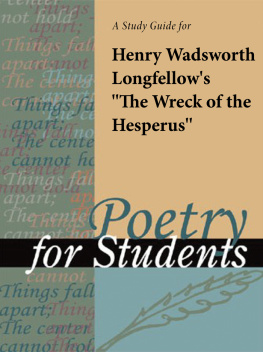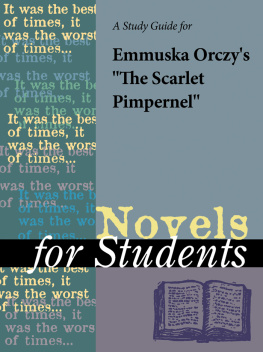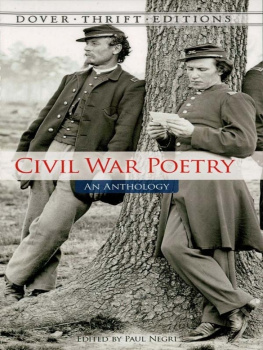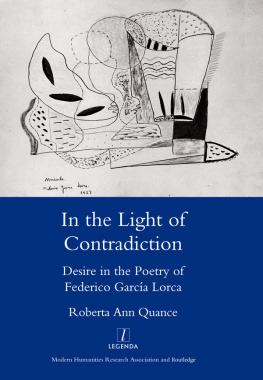TABLE OF CONTENTS
Guide
Poetry for Students, Volume 31
Project Editor: Sara Constantakis
Rights Acquisition and Management: Jacqueline Flowers, Kelly Quin, Mardell Glinski Schultz, Robyn Young
Composition: Evi Abou-El-Seoud
Manufacturing: Drew Kalasky
Imaging: John Watkins
Product Design: Pamela A. E. Galbreath, Jennifer Wahi
Content Conversion: Katrina Coach
Product Manager: Meggin Condino
2010 Gale, Cengage Learning
ALL RIGHTS RESERVED. No part of this work covered by the copyright herein may be reproduced, transmitted, stored, or used in any form or by any means graphic, electronic, or mechanical, including but not limited to photocopying, recording, scanning, digitizing, taping, Web distribution, information networks, or information storage and retrieval systems, except as permitted under Section 107 or 108 of the 1976 United States Copyright Act, without the prior written permission of the publisher.
Since this page cannot legibly accommodate all copyright notices, the acknowledgments constitute an extension of the copyright notice.
For product information and technology assistance, contact us at Gale Customer Support, 1-800-877-4253.
For permission to use material from this text or product, submit all requests online at www.cengage.com/permissions.
Further permissions questions can be emailed to permissionrequest@cengage.com
While every effort has been made to ensure the reliability of the information presented in this publication, Gale, a part of Cengage Learning, does not guarantee the accuracy of the data contained herein. Gale accepts no payment for listing; and inclusion in the publication of any organization, agency, institution, publication, service, or individual does not imply endorsement of the editors or publisher. Errors brought to the attention of the publisher and verified to the satisfaction of the publisher will be corrected in future editions.
Gale
27500 Drake Rd.
Farmington Hills, MI, 48331-3535
ISBN-13: 978-1-4144-2148-3
ISBN-10: 1-4144-2148-6
ISSN 1094-7019
This title is also available as an e-book.
ISBN-13: 978-1-4144-4952-4
ISBN-10: 1-4144-4952-6
Contact your Gale, a part of Cengage Learning sales representative for ordering information.
Printed in the United States of America
1 2 3 4 5 6 7 13 12 11 10 09
The Wreck of the Hesperus
Henry Wadsworth Longfellow
1841
Introduction
Henry Wadsworth Longfellow's "The Wreck of the Hesperus" recounts the story of the shipwreck of a schooner Longfellow calls Hesperus in a severe hurricane off the coast of New England. Although nature is portrayed as unrelenting and brutal in some of its manifestations, the force of "The Wreck of the Hesperus" comes from Longfellow's portrayal of the human traits of pride and stubbornness in the face of nature's fierceness. The storm does not constitute the tragic aspect of the tale Longfellow tells; the captain's hubris does. Hubris is the term used to describe the pride that characterizes the heroes of Greek tragedy, the kind of pride that blinds people to their limitations and allows them to pit their will against the will or power of supernatural elements, like the gods or fate in Greek tragedy, or great natural forces, like the hurricane in "The Wreck of the Hesperus." Hubris is clearly at work in the captain's proud and foolish refusal to heed the old sailor's warning. So is sacrifice, for when the captain realizes the danger, once the storm has struck and the schooner has foundered, he gives up his chance for survival, wrapping his daughter in his greatcoat and tying her to the ship's mast with the hope that she will survive instead. Although she does not, it is the combination of the captain's pride and his self-transcendence in his sacrifice that makes him a tragic hero and not just a victim of his own ill-considered decisions and stubborn response to circumstances.
A major source of the poem's charm is the ballad form in which it is written. The four-line stanzas, the rhymed second and fourth lines, and the slightly archaic language that characterize the ballad form give the events described a framework that transforms them from recreated experience into art. The poem becomes a kind of cameo within which the events are inscribed and made accessible so as to inspire a reader's aesthetic response of terror at the event and pity for human suffering. "The Wreck of the Hesperus" is available in Henry Wadsworth Longfellow: Poems and Other Writings, published in 2000.
Author Biography
Longfellow was born in Portland, Maine, on February 27, 1807, the second of eight children. His mother, Zilpah, was a pacifist. His father, Stephen, was a lawyer, a member of Congress from Maine, and a trustee of Bowdoin College. After graduating from Portland Academy, Longfellow attended Bowdoin beginning in 1821. He joined the Bowdoin faculty as a professor of modern languages soon after receiving his degree in 1825. Upon taking this position, Longfellow spent three years living in France, Spain, Italy, and Germany studying the countries' languages, literatures, and cultures. He began teaching at Bowdoin in 1829. For the next several years, Longfellow neglected poetry, which he had been writing as an undergraduate, and focused on scholarship, translating or editing a number of modern language texts as well as writing scholarly essays on European literature. In 1834, Longfellow published a prose account of his European travels, Outre-Mer: A Pilgrimage Beyond the Sea. In 1831 he married Mary Storer Potter, and in 1834 he accepted a position teaching modern languages at Harvard College. Together with Mary, Longfellow went back to Europe for a year in April 1835, mastering Dutch, Danish, Icelandic, and Swedish during the visit. Sadly, in November 1835, while they were in Holland, Mary died of a miscarriage; Longfellow was disconsolate. In July 1836, while in Switzerland, Longfellow met Frances Appleton, and after a long courtship, they married in 1843. Their marriage was a happy one, but Fanny died on July 10, 1861, after her clothes caught on fire, perhaps when a lighted candle tipped over and fell onto her skirts. Longfellow was again inconsolable. He was distressed at the time also because of the Civil War, being both a pacifist and an opponent of slavery.
In 1839, Longfellow published his first collection of poetry, Voices of the Night. Ballads and Other Poems, which includes "The Wreck of the Hesperus," was published in 1841. A verse drama, The Spanish Student, was published in 1843. From 1843 until the death of his second wife in 1861, Longfellow wrote and published some of his most popular poetry, including Evangeline: A Tale of Acadie (1847), The Song of Hiawatha (1855), The Courtship of Miles Standish (1858), and "Paul Revere's Ride" (1861). In 1854, the success of his poetry allowed Longfellow to resign his position at Harvard. After Frances's death, Longfellow devoted much of his attention to working on Christus: A Mystery, a three-part dramatic epic that he began in 1849 and published in 1872. In 1868, Longfellow traveled again to Europe, where he was repeatedly honored as a great contributor to American letters and culture. Longfellow died of peritonitis, an abdominal disease, on March 24, 1882, in Cambridge, Massachusetts. He was buried beside both his wives in the Mount Auburn Cemetery in Cambridge.






















